I ran out of pickled green chili a while ago and quickly got about making it. In our home, this is an important condiment. If we don’t have this, we cannot eat fried noodles.
For my post on Pickled Green Chili click here. Er, it would be pretty dumb to post a condiment on its own without showing what goes perfectly with it. So here it is–Fried Rice Vermicelli or Chow Mifun, Cantonese home-style noodles.
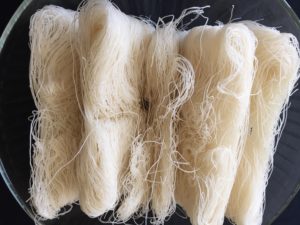 The Cantonese love their mifun, rice vermicelli. When I discovered my great-grandfather’s house in Dungguan in China nearly 30 years ago, I was delighted to find that this area was famous for its rice vermicelli. My Popo, grandmother, loved mifun, as did Mum. They preferred the type that has very fine strands. Years ago we used the Pearl River brands but I’ve since found Hsinchu mifen and Thai rice vermicelli excellent in quality.
The Cantonese love their mifun, rice vermicelli. When I discovered my great-grandfather’s house in Dungguan in China nearly 30 years ago, I was delighted to find that this area was famous for its rice vermicelli. My Popo, grandmother, loved mifun, as did Mum. They preferred the type that has very fine strands. Years ago we used the Pearl River brands but I’ve since found Hsinchu mifen and Thai rice vermicelli excellent in quality.
This is a great meal for lunch and can also be offered as a side for a bigger dinner or buffet. It’s a great potluck dish because it can be eaten at room temperature.
Variation of Stir Fry
Frying noodles is just a slight step up of a simple stir fry. The technique is the same, except it is made in two parts. Basically, you start with a stir fry of a combination of aromatics, meat, and vegetables. Then you set that aside. Then you repeat a second stir fry–of aromatics but with only noodles. Then you combine the first lot of meat and veggies with the noodles. Toss and da-dah! Home fried noodles.
My Chow Mifun is inspired by memory of my grandfather’s second wife, whom I also call Ah Mah. Ah Mah made this for lunch once, and she put in pork, prawns, mushroom and choy sum. Here I skipped the prawns because, well, I didn’t have any.
Here are my posts on some basic stir frying.
Quick Stir Fried Vegetables, click here.
Stir Fried Beef With Green Onions, click here.
I’ve also done on post on Rice Vermicelli.
Click here to find out how much to use and how to prep.
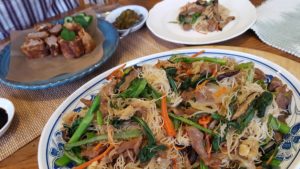
Fried Rice Vermicelli (Chow Mifun)
Makes 6 cups
Preparation time: 30 minutes
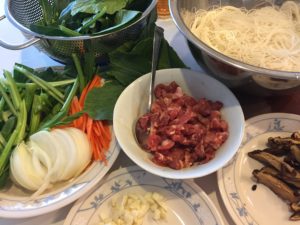
10 ounces (250 grams) rice vermicelli, two panels of noodles
8 ounces (200 grams) pork, sliced into strips
4 tablespoons oil
3 cloves garlic, chopped
¼-½ cup sliced onion
¼-½ cup carrots
2 dried Chinese mushroom, soaked and sliced thinly
2 bunches choy sum, cut in strips
1 tablespoon oyster sauce
½ cup stock or water
Marinade for meat
3 teaspoons soy sauce
1/8 teaspoon sugar
1/8 teaspoon pepper
¼ teaspoon cornstarch
Seasoning for noodles
2 tablespoons oyster sauce
1 tablespoon soy sauce
½ teaspoon salt
Soften rice vermicelli in warm water for about 10 minutes until noodle is no longer stiff. Separate strands and drain well.
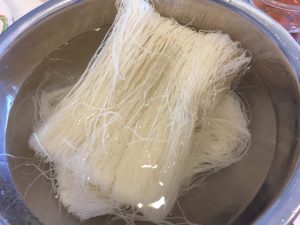
Marinate meat in soy sauce, sugar, pepper and cornstarch for 15 minutes.
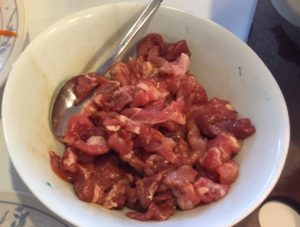
Heat 1 tablespoon oil in a hot non-stick pan and when oil is shimmering fry meat until semi cooked. Return meat to marinating bowl.
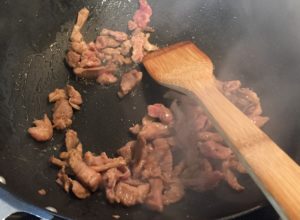
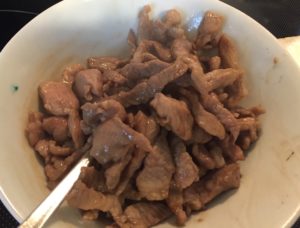
Heat another tablespoon oil in pan, add half the garlic, onion, carrot and mushroom and fry for 30-45 seconds. Add green vegetables and fry for another 30 seconds.
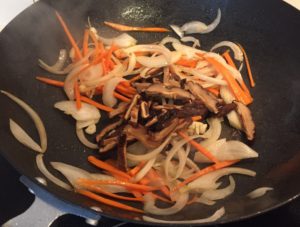
Return meat with juices to pan, add oyster sauce and fry to mix well. Add stock and fry another 20-30 seconds until pork is fully cooked. Transfer ingredients to a bowl and set aside.
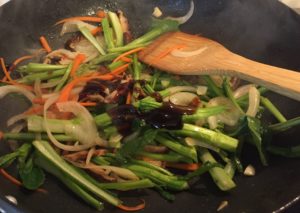
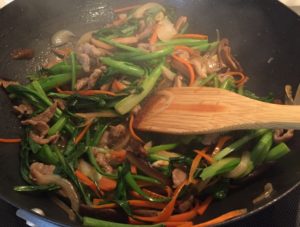
Add remaining oil to pan, heat and fry the remaining garlic. Fry garlic till golden, add noodles and fry for 20 seconds, lowering heat to medium halfway. Sprinkle oyster sauce, soy sauce and salt over noodles and toss noodles gently with chopsticks to mix.
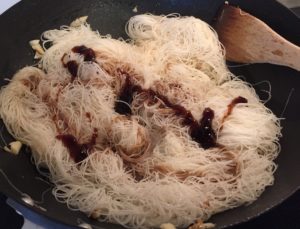
Return vegetables and pork to pan and toss well. Reduce heat to low. If noodles get dry during frying, sprinkle 2-4 tablespoons water or stock to steam and moisten noodles.
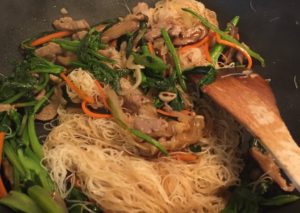
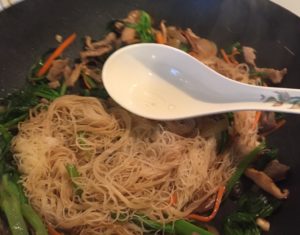
Test noodle to see if it is salty and soft enough. Adjust for taste. If noodle is tender, remove pan from heat and toss to mix vegetables and meat well into noodles. If noodle is still cool, sprinkle some stock or water and continue to toss until seasoning and ingredients are well combined.
Serve hot or warm.
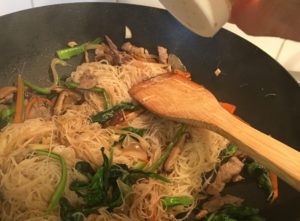
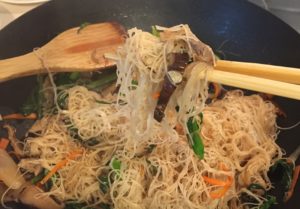
NOTES
When frying the noodles, don’t just stir the blob of noodles around. With your spatula, lift the noodles at the bottom of the pan up and move it to the top. Then leave the noodles to get slightly fried by the heat of the pan and repeat scooping it up to the top. Continue mixing this way.
Use chopsticks to toss the noodles with the meat and vegetables. Yup, practice your chopstick skills. They separate the noodles more efficiently than a spatula.
I like to have a can of chicken stock at hand to sprinkle it on the noodles when they are dry. It adds a better flavor.
When the noodles get more cooked and soften, moving them around too vigorously with a spatula could cause them to break into tiny strips. Remove from heat and continue to toss with chopsticks to mix the ingredients well.
A perfectly fried mifun should have long, tender strands. If it break into inch-long pieces, you’ve overcooked your noodles.
VARIATIONS
–Add 6-8 ounces prawns (150-200 grams) to ingredients.
Lightly salt prawns before use. Fry prawns in 1 tablespoon of oil. Remove as soon as prawns turn red. Set aside. Continue to fry the meat and vegetables according to above recipe and then return meat–and prawns–to mix.
Continue frying noodles, according to the recipe above.
–Instead of pork, you may use same amount of chicken or beef.
–Instead of choy sum or Shanghai bai cai, you may also use Napa cabbage, chive flowers, leeks, and/or any leafy vegetables.
